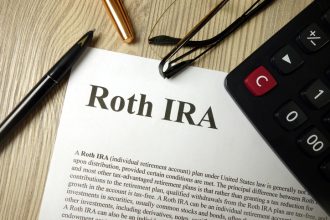Managing multiple 401(k) accounts from past employers involves tracking different fees, investment options, and statements. Consolidating these accounts can simplify monitoring, reduce costs and keep investments aligned with retirement goals. A financial advisor can help you evaluate consolidation options and determine a strategy for your retirement savings.
Ways to Consolidate Your 401(k) Accounts
When consolidating 401(k) accounts, three general options you can consider:
- Roll over into your current employer’s plan. This option keeps everything in one place, making it easier to track contributions, investment choices and fees. Before rolling over, though, it’s important to confirm whether your employer’s plan accepts rollovers and to review the investment options to ensure they meet your long-term goals.
- Consolidate into an IRA. IRAs generally offer a wider range of investment options than most employer plans, giving you more flexibility and control over your portfolio. They may also simplify account management by allowing you to combine multiple old 401(k)s into one account. However, it’s worth noting that fees and protections can differ from employer-sponsored plans.
- Leave funds in an existing plan. While less common, some individuals choose to consolidate old accounts by leaving funds with a former employer’s plan, provided it offers solid investment options and low costs. If you have multiple old accounts, you might move them all into the one you consider the most competitive. However, not all plans allow this, and you may face restrictions on future contributions, so this route requires careful attention.
When picking a consolidation option, keep these things in mind: compare fees, investment options, and accessibility. Employer plans may have lower-cost investments, while IRAs offer more flexibility but can carry higher fees.
Steps to Consolidate One 401(k) into Another

Consolidating one 401(k) into another involves a series of steps. Doing so could help you reduce fees and simplify account oversight. Here are key steps to consider when consolidating one 401(k) to another.
1. Review Plan Rules
Start by checking whether your current employer’s 401(k) plan accepts rollovers from old accounts. Each plan has its own rules and restrictions, and confirming eligibility upfront saves time and prevents delays. You should also review the investment options in your current plan to make sure they align with your retirement strategy.
2. Contact Your Former Plan Administrator
Once you’ve decided to roll over, reach out to your old employer’s plan administrator to initiate the process. They will provide the necessary forms and instructions, and in most cases, you’ll want to request a direct rollover. A direct transfer moves funds between accounts without triggering unnecessary taxes or penalties.
3. Coordinate With Your Current Plan Provider
At the same time, inform your new plan administrator that a rollover is coming. They will guide you on how to properly deposit the funds and may provide account-specific paperwork to streamline the process. Staying in close communication with both sides helps ensure a smooth and timely transfer.
4. Verify the Transfer
After the rollover is complete, check your account to confirm that all funds have arrived safely and were allocated correctly. This is also a good time to revisit your investment selections to make sure they match your goals. Keeping documentation of the rollover can be helpful for tax purposes and future reference.
How to Find Your 401(k)s
If you’ve changed jobs over the years, each employer where you contributed to a retirement plan may still be holding your 401(k) funds. Contacting the human resources or benefits department is often the fastest way to get information about your account. They can confirm whether your funds remain in the company plan and provide instructions on how to access them.
Digging through past paperwork can also uncover forgotten accounts. Old pay stubs, tax forms or quarterly statements may contain the name of the plan provider and your account details. Even if the contact information is outdated, it can point you in the right direction to track down the plan.
The National Registry of Unclaimed Retirement Benefits is another valuable resource if you’ve lost touch with an old account. This database allows you to search for unclaimed funds tied to your Social Security number. While not every plan reports to the registry, it’s an easy way to identify accounts you may have overlooked.
Finally, the U.S. Department of Labor maintains records of retirement plans and can be a helpful source for finding missing accounts. If a former employer went out of business or changed names, the Department’s database may still provide a trail to the plan administrator. This may prove particularly useful when traditional methods fall short.
When to Consolidate Your 401(k) Accounts
One of the most common times to consolidate is after leaving a job. Each job change can leave a separate One of the most common times to consolidate is after leaving a job. Each job change can leave a separate 401(k), creating multiple accounts to track. Moving funds into your current plan or an IRA makes retirement savings easier to manage.
If you notice that one of your old 401(k)s carries higher fees than your other options, consolidation can reduce those costs. Employer plans and IRAs vary in terms of expense ratios, administrative charges and investment options. Moving funds into a more cost-effective plan may free up more of your savings for long-term growth.
Another reason to consolidate is to simplify portfolio management. Having your accounts in one place makes it easier to review performance, adjust allocations, and keep your investments aligned with your goals.
Additionally, as retirement nears, having fewer accounts can reduce the risk of missing required minimum distributions or overlooking an important detail. Consolidation simplifies withdrawal planning and helps you better coordinate income from your savings. This preparation can make your transition into retirement smoother and less stressful.
Bottom Line

Consolidating your 401(k) accounts can help you gain clarity and control over your retirement savings. Fewer accounts could mean lower fees, simpler investment decisions, and a clearer path toward long-term goals. You can roll old accounts into a new employer plan, transfer them to an IRA, or work with a financial advisor to review your options.
Retirement Planning Tips
- A financial advisor can help you determine whether you have enough saved for retireement and recommend strategies to grow your nest egg. Finding a financial advisor doesn’t have to be hard. SmartAsset’s free tool matches you with vetted financial advisors who serve your area, and you can have a free introductory call with your advisor matches to decide which one you feel is right for you. If you’re ready to find an advisor who can help you achieve your financial goals, get started now.
- If you want to diversify your portfolio, here’s a roundup of 13 investments to consider.
Photo credit: ©iStock.com/designer491, ©iStock.com/PeopleImages, ©iStock.com/c-George
Read the full article here














